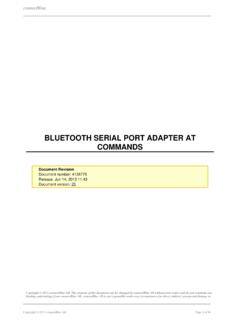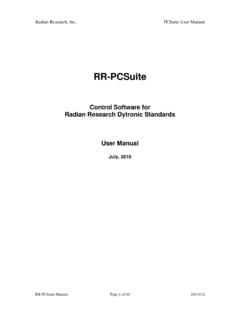Transcription of WEGMATTLLC dAISy HAT AIS Receiver
1 WEGMATTLLC dAISy HAT AIS Receiver 1 Contents 2 Disclaimer ..2 3 Configuring the Raspberry Pi for the dAISy HAT ..2 Recent versions of Raspian Jessie .. 2 Older versions of Raspian Jessie Raspberry Pi, Pi 2 and Pi Zero .. 3 Older versions of Raspian Jessie Raspberry Pi 3 .. 4 Configuration in OpenCPN .. 4 Connecting dAISy with other software .. 5 4 Using dAISy ..6 Interpreting the status LEDs .. 6 Configuration and debug menu .. 7 5 Using the breakout connections ..9 serial 1 header .. 9 serial 2 header .. 9 I2C header .. 10 Debug header .. 10 RF connectors .. 10 6 Tips for good AIS reception .. 11 Antenna .. 11 Location, location, location .. 11 Radio noise .. 12 7 Troubleshooting .. 13 8 Source code and 14 9 Contact.
2 14 Wegmatt LLC 6356 138th Ave NE #212 Redmond, WA United States of America Designed and assembled in USA 2 Disclaimer dAISy HAT is a reliable, dual-channel AIS Receiver . However, under no circumstances it should be solely relied on for collision avoidance or navigation. It s the user s responsibility to use the product prudently. Neither Wegmatt LLC nor its dealers accept responsibility or liability to the product user or their estate for any accident, loss, injury or damage whatsoever arising out of the use of this product. 3 Configuring the Raspberry Pi for the dAISy HAT The dAISy HAT communicates with the Raspberry Pi through the serial port broken out one the Raspberry Pi s expansion header. Out-of-the-box, the Raspberry Pi uses these pins for other purposes like a serial terminal or Bluetooth.
3 Reconfiguring serial ports is straight forward with recent versions of Raspian Jessie (since ca. late 2016). Configuration can be more complex with older version of Raspian, especially on the Raspberry 3. For beginners, we recommend to start with a new image of Raspian Jessie. Recent versions of Raspian Jessie The uart_control shell script Ilker Temir is the easiest way to configure the serial port on a Raspberry Pi. Open a terminal window on your Raspberry Pi and execute the following commands: 1. wget 2. chmod +x ./uart_control 3. sudo ./uart_control gpio 4. sudo reboot now This will download the script, make it executable, run it to reconfigure the serial port for use with a HAT, and rebooting the Raspberry Pi to make the new configuration active.
4 After completing the reboot, AIS data is available using the following parameters: serial port /dev/serial0 Baud rate 38400 Data bits 8 Parity None Stop bits 1 Flow control None Use this information to configure OpenCPN or other programs. Keep in mind, that only one application at a time can consume serial data. You can verify the serial connection with a serial terminal program like for example screen. You may have to install screen first by running: sudo apt-get install screen With screen installed, connect to the dAISy HAT with screen /dev/serial0 38400 If the serial port is properly configured, pressing ESC will bring up the configuration and debug menu. Pressing ESC again will return dAISy into receive mode. Exit screen by pressing CTRL-A, K and Y.
5 Older versions of Raspian Jessie Raspberry Pi, Pi 2 and Pi Zero Older versions of Raspian require more manual steps to reconfigure serial ports . If you have a Raspberry Pi, Raspberry Pi 2 or Raspberry Pi Zero, follow the steps outlined in the tutorial for the Adafruit GPS HAT. After completing the reboot, AIS data is available using the following parameters: serial port /dev/ttyAMA0 Baud rate 38400 Data bits 8 Parity None Stop bits 1 Flow control None Use this information to configure OpenCPN or other programs. Keep in mind, that only one application at a time can consume serial data. You can verify the serial connection with a serial terminal program like for example screen. You may have to install screen first by running: sudo apt-get install screen With screen installed, connect to the dAISy HAT with screen /dev/ttyAMA0 38400 If the serial port is properly configured, pressing ESC will bring up the configuration and debug menu.
6 Pressing ESC again will return dAISy into receive mode. Exit screen by pressing CTRL-A, K and Y. Older versions of Raspian Jessie Raspberry Pi 3 The Raspberry Pi 3 uses its serial port for the built-in Bluetooth module. Reconfiguring this with older versions of Raspian can be quite complex and error prone. We strongly recommend to use an up-to-date version of Raspian and follow the steps outline in chapter above instead. If you still want to reconfigure an older version of Raspian, this blog post may help you: After completing the reboot, AIS data is available using the following parameters: serial port /dev/ttyAMA0 Baud rate 38400 Data bits 8 Parity None Stop bits 1 Flow control None Use this information to configure OpenCPN or other programs.
7 Keep in mind, that only one application at a time can consume serial data. You can verify the serial connection with a serial terminal program like for example screen. You may have to install screen first by running: sudo apt-get install screen With screen installed, connect to the dAISy HAT with screen /dev/ttyAMA0 38400 If the serial port is properly configured, pressing ESC will bring up the configuration and debug menu. Pressing ESC again will return dAISy into receive mode. Exit screen by pressing CTRL-A, K and Y. Configuration in OpenCPN OpenCPN is a free chart plotter and navigation software. Among many other things, OpenCPN supports input from AIS receivers to display the position of ships on its charts. You can learn more about OpenCPN on There are several tutorials on the web on running OpenCPN on a Raspberry Pi.
8 The consensus is, that you should only attempt this on a Raspberry Pi 3 with an up-to-date version of Raspian. A very good write-up of the process can be found here: Once OpenCPN is running on the Raspberry Pi, configure it for the dAISy HAT. Go to the Options dialog, select the Connections icon and add a new connection. Set Properties to serial . Enter or select the Dataport under which dAISy presents itself (see chapters above to determine the correct port). Set Baudrate to 38400. Leave everything else as preset by OpenCPN. Configuration of a serial connection for dAISy in OpenCPN Connecting dAISy with other software dAISy presents itself to computers as a serial port. See the configuration chapters above about installation to learn how to determine the serial port.
9 The serial communication parameters of dAISy are: Baud rate 38400 Data bits 8 Parity None Stop bits 1 Flow control None Depending on the software dAISy is used with, some or all parameters must be configured. For details, please refer to the instruction manual of the respective application. 4 Using dAISy Using dAISy is as simple as connecting it with an antenna and a PC and powering up your AIS capable application of choice. When plugged in, dAISy automatically starts to listen for AIS transmissions. Interpreting the status LEDs The dAISy HAT has two two-color status LED, giving us some indication about how it s feeling. Each LED represents one of the two AIS channels. Short GREEN flash every 5 seconds dAISy is well and alive and in receive mode.
10 While in receive mode, the mode dAISy starts in when powered up, it will very briefly blink green every 5 seconds to indicate that everything is ok. Long GREEN flash Yay! dAISy received a valid AIS packet. For every packet received and passing all error checks, the LED will turn green for second. At the same time, dAISy will send the received message to the Raspberry Pi. Long RED flash dAISy received an invalid packet. dAISy caught the start of a package, but the received data did not pass other sanity checks like encoding standard or checksum. It might be a ship just out of range, interference from another radio source, or just random noise. Don t panic, you will see a lot of red even under optimal conditions. RED turned on permanently dAISy failed to initialize the radio IC.






